-
Posts
12420 -
Joined
-
Last visited
-
Days Won
551
Content Type
Profiles
Forums
Events
Everything posted by Fiery
-
Updating the Power Manager application will not help in this case, but it's of course good to have the latest version installed. Please stay with the latest AIDA64 beta. We're already working on a special method for AIDA64 ThinkPad EC module to eliminate the direct EC calls, and so eliminate the collisions with the ThinkPad Power Manager application. Please give us a couple of days to finish up and properly test the new AIDA64. As for the temperature and fan speed spikes, they are all due to collisions between AIDA64 and the ThinkPad Power Manager application. Just ignore any unusually high or low values. Thanks, Fiery
-
Thank you for the test. 144 Celsius is an incorrect value that is read only because AIDA64 EC register readout collides with the ThinkPad Power Manager application or some other application that also accesses the EC simultaneously with AIDA64. At 144 Celsius your CPU would fry and would never work again We'll work more on the EC access method, we'll try to synchronize it with Lenovo's own software to avoid collisions. But, if you can somehow temporarily close or disable those Lenovo power management software, you could see the warnings and errors become the rate I've mentioned above (1 per hour). CPU2 means the 2nd logical processor, which in your case is the 2nd core of your CPU.
-
We've implemented Used Memory, Free Memory, Used Swap Space, Free Swap Space sensor icons, all in GigaBytes. Make sure to upgrade to the latest beta version of AIDA64 Extreme Edition available at: http://www.aida64.com/downloads/aida64extremebuild1917z8kpq0xdhvzip After upgrading to this new version, make sure to restart Windows to finalize the upgrade. Let me know how it works. Thanks, Fiery
-
We've implemented the Swap Space Utilization hardware monitoring item to let you diagnose your systems more easily. Implementing paging file information as a hardware monitoring item would be quite difficult, since you can have one or a lot of paging files. As for the virtual memory information, we'll wait for more users requests, since at this time we're not convinced it is a meaningful readout that people wanna monitor. Most people are confused about virtual memory readouts, and we prefer not to overcrowd the hardware monitoring items with confusing bits Make sure to upgrade to the latest beta version of AIDA64 Extreme Edition available at: http://www.aida64.co...17z8kpq0xdhvzip After upgrading to this new version, make sure to restart Windows to finalize the upgrade.
- 2 replies
-
- Swap Space Utilization
- Virtual Memory Utilization
- (and 1 more)
-
We've fine-tuned the Embedded Controller register readout in the latest beta version of AIDA64 Extreme Edition available at: http://www.aida64.co...17z8kpq0xdhvzip After upgrading to this new version, make sure to restart Windows to finalize the upgrade. Let me know how it works. There's a chance you'd still get occasional warnings in the Event Log, but it should be much less frequent than before, typically one per hour or even more rare. Everyone else reading this: please note that this issue only affects Windows XP systems. ThinkPads with Windows Vista or Windows 7 are not affected by this issue at all, fortunately.
-
We've implemented the new Multimedia / SAPI page in the latest beta version of AIDA64 Extreme Edition available at: http://www.aida64.com/downloads/aida64extremebuild1917z8kpq0xdhvzip After upgrading to this new version, make sure to restart Windows to finalize the upgrade. Let me know how it works. Thanks, Fiery
-
We've implemented the requested new hardware monitoring items. Make sure to upgrade to the latest beta version of AIDA64 Extreme Edition available at: http://www.aida64.com/downloads/aida64extremebuild1917z8kpq0xdhvzip After upgrading to this new version, make sure to restart Windows to finalize the upgrade.
-

fixed: Grisoft AVG 2012 and AVG 2013 antivirus not detected
Fiery replied to petrs's topic in General Discussion
Here it is: http://www.aida64.com/downloads/aida64businessbuild1917v6fthk9czwzip -
[ just to clarify ] The GTX680 RSoD issue has already been fixed in the latest beta release of AIDA64 Extreme Edition available at: http://www.aida64.co...13tqrs2v6chnzip After upgrading to this new version, make sure to restart Windows to finalize the upgrade. Regards, Fiery
-
It looks like a very useful tool indeed. However, with AIDA64 we focus on reporting 100% accurate system details, and measure system performance using state-of-the-art benchmark methods. We currently do not have the resources to make AIDA64 a tweaking tool. However, in case you have an idea about how to improve the Auto Start programs reporting capabilities of AIDA64, post it into this topic Regards, Fiery
-
Thank you for the tests. I assume you are using AIDA64 v2.30?
-
I'll drop a message into this topic once an enhanced ThinkPad EC handling in AIDA64 is available. I'm afraid I can't provide you with a timeframe at this time, since it will heavily depend on the time it takes us to get a fitting ThinkPad, and then the time it takes to configure it and reproduce the issue. And then more time until we can come up with some sort of solution We'll do our best though. Until then, you shouldn't worry too much about the EC collision. As long as your computer runs stable, such Windows Event Log warnings are just warnings
-
We definitely need to diagnose this issue to possibly come up with an indirect EC access method that Windows doesn't treat unsafe. Please let me know what ThinkPad model do you have, so we could get a similar one for test runs.
-
1) Does the Computer / Sensor page display correctly? 2) Do you have similar lockups if you try push the New button in AIDA64 / main menu / File / Preferences / Hardware Monitoring / Alerting? Thanks, Fiery
-

fixed: Grisoft AVG 2012 and AVG 2013 antivirus not detected
Fiery replied to petrs's topic in General Discussion
We have worked quite a bit on Comodo Antivirus and Comodo Internet Security, but all we could figure out is how to detect their installation status and product version -- that will be implemented in the next AIDA64 beta release. However, we couldn't figure out how to detect virus database date or virus signature count for Comodo products -
AIDA64 uses direct EC (Embedded Controller) register read calls in its kernel driver to measure various system temperatures on ThinkPads. Those warnings in the Event Log indicate Windows catches the low-level EC calls of AIDA64 and find them a bit "odd". It's only a warning, you don't need to worry about it.
-
Thank you for the feedback
-
Thank you. We've fixed a bug in the mobile CPU detection part of AIDA64. Make sure to upgrade to the latest beta version of AIDA64 Extreme Edition available at: http://www.aida64.co...13tqrs2v6chnzip After upgrading to this new version, make sure to restart Windows to finalize the upgrade. Let me know how it works. Thanks, Fiery
-

Need North Bridge temperature (ASRock 990FX Professional)
Fiery replied to tw33k's topic in Hardware monitoring
Please post a screen shot that shows HWMonitor readings and AIDA64 Computer / Sensor page side-by-side, so we can compare the readings against each other. Thanks, Fiery -
What I can tell you is that apart from this topic, we never got any bug reports about ThinkPad and AIDA64 incompatibility or stability issues. When we tested ThinkPads in the past, we haven't found any issues. Truth be told, we didn't try to run ThinkPad Power Manager and AIDA64 together to try and see if there's a collision between them. Our current test hardware collection doesn't include any ThinkPads, but in case multiple users can confirm here (in this topic) that there's a definitive issue about one or more ThinkPad models while running AIDA64, then we can arrange to get an affected notebook part, and try reproducing the bug and then fixing it.
-
Rendition seem to be a bit "lazy", since they only rebrand the Crucial (Micron) memory modules, without altering the SPD block to put their manufacturer ID replacing Crucial's there. The reason behind that may be that Rendition doesn't have a JEDEC manufacturer's identification code allocated (yet). BTW, Micron makes great memory modules, so there's nothing wrong with your memory module, no matter what the SPD manufacturer code says Regards, Fiery
-
1) Please right-click on the bottom status bar of AIDA64 main window --> CPU Debug --> CPUID & MSR Dump. Copy-paste the full results into this topic. 2) Then right-click on the bottom status bar of AIDA64 main window --> System Debug --> PCI Dump. Copy-paste the full results into this topic. Thanks, Fiery
-

fixed: Grisoft AVG 2012 and AVG 2013 antivirus not detected
Fiery replied to petrs's topic in General Discussion
What version of Comodo Internet Security do you have installed? -
1) We'll add the "Save Report" line to the language modules soon. 2) Those 3 lines are not meant to be translated. 3) We'll fix this issue in the next AIDA64 beta release. Thanks, Fiery
-

Motherboard sensor reading stuck (ASRock 990FX Professional)
Fiery replied to tw33k's topic in Hardware monitoring
I don't think the motherboard temperature reading is stuck. In this dump you have 30 Celsius, while in your other topic the motherboard temperature is 32 Celsius. Hence it does change. Make sure to compare AIDA64 sensor readings against ASRock F-Stream readings. If you see a discrepancy there, please post a screen shot that shows AIDA64 Sensor page and F-Stream readings next to each other (side-by-side), so we can compare the values.


